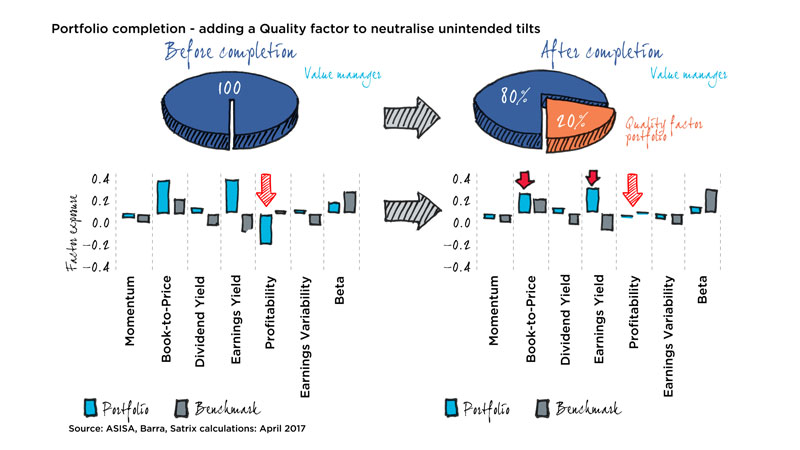Address factor gaps or tilts in your portfolio

Part 2/10: ADDRESS FACTOR GAPS OR TILTS IN YOUR PORTFOLIO
Client level of adoption/allocation:

In the first article in our series on factor investing we explained what these factors are. We also touched on how you could use factor investing to break down where the performance of your portfolio comes from and evaluate how much alpha – outperformance – your active manager is really adding.
In part 2 of this series we take the next logical step: we discuss how you can do something about those factor exposures. This concept is typically referred to as ‘portfolio completion’.
As the word suggests, portfolio completion is the exercise of adding or reducing specific exposures to your portfolio to fill a gap and achieve a targeted portfolio strategy. This step usually involves only a minor allocation to a factor, but is vitally important to address your specific investment needs appropriately.
Let’s take an example of an equity value manager. After examining the portfolio’s factor exposures relative to the benchmark, we observe a significant underweight in the profitability factor exposure (see Figure 1).
Figure 1: Portfolio completion – adding a Quality factor to neutralise unintended tilts

Since most factors are not free from exposure to the others (styles overlap), it is likely that while trying to gain exposure to certain targeted exposures, other undesired factor exposures may creep in. And while perfectly disentangling these factors is not always realistic, it would make sense to at least neutralise these unintended exposures. This should ensure that the portfolio achieves enhanced purity in the targeted exposures as well as mitigating any meaningful portfolio risks through unintended factor exposures.
In our example, while targeting a Value strategy (particularly if shaped around a dividend yield factor), an unintentional but significant consequence is an underexposure to profitability. Profitability, being a factor within the Quality family of factors, has proven to be one of the most consistently strong factor signals in South Africa. As such, being meaningfully underexposed to this factor may compromise the premium added by the targeted Value factor. The objective then is to neutralise the profitability exposure by adding a small allocation (20%) to Quality, while not substantially diluting the intended Value exposure. We achieved this in our example.
What we’re trying to achieve here is the best balance between diluting the desired factor exposures and enhancing the diversification of the fund. This trade-off exists due to the factor used for completion (Quality) often being somewhat negatively correlated with the existing portfolio (Value).
Portfolio completion offers the added bonus of better portfolio diversification, while the investor can also leave the active manager to continue with its specific style and thereby not constrain its process.





Comments are closed.